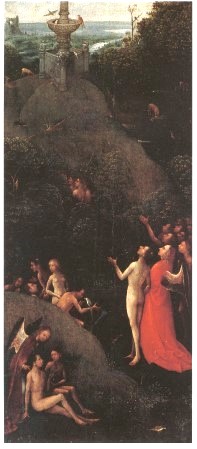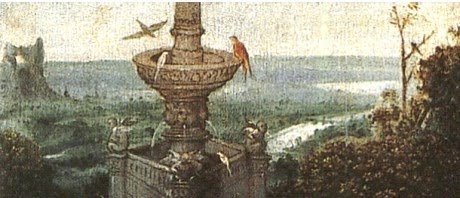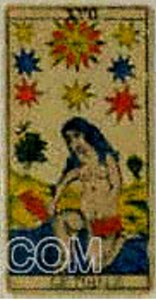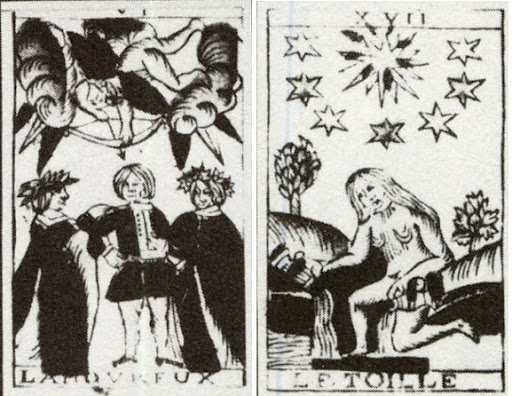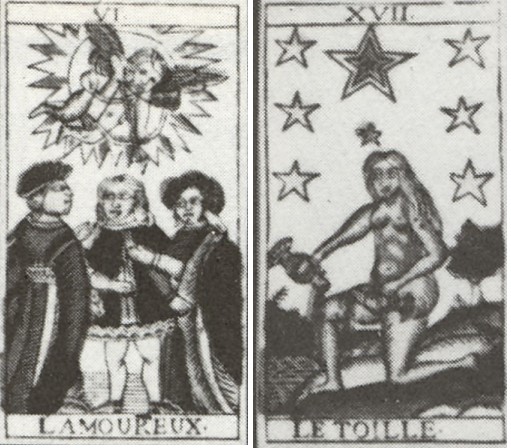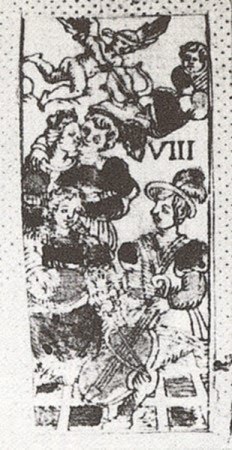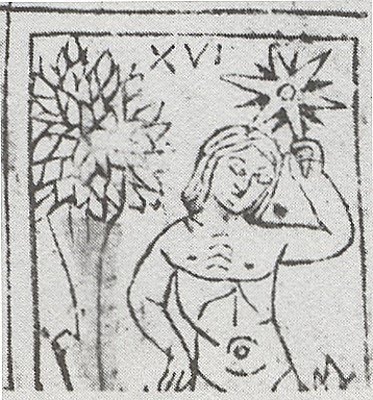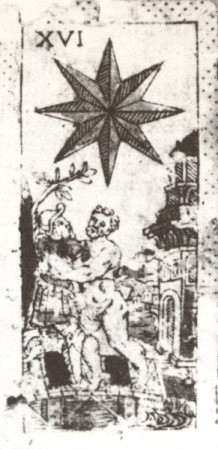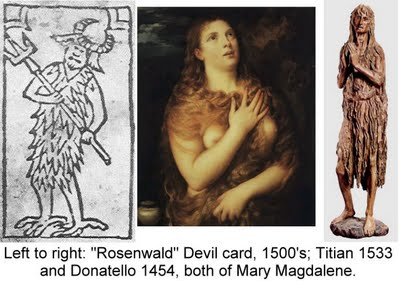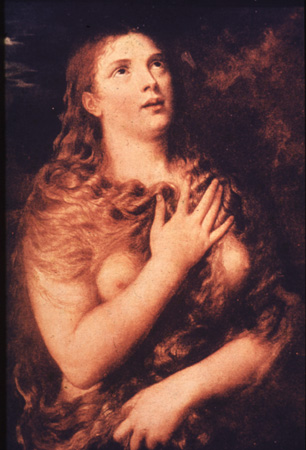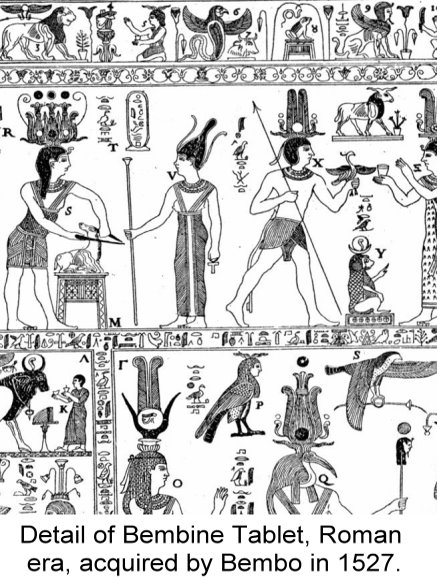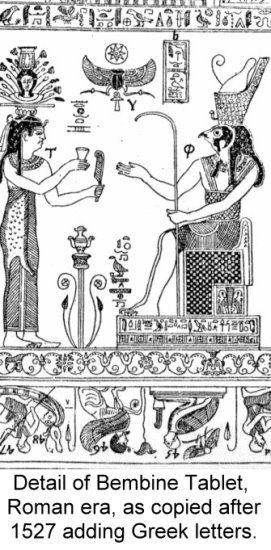Le Toille, Odysseus, and Circe
This post has two parts. For me, the first led to thinking about the second. But each stands or falls on its own merits. Part One is about the printed title of the Dodal Star card, c. 1701. It leads to Part Two, where I bring in Greek mythology. That part also brings in two other early versions of the card (15th or 16th century, according to Kaplan), ones not often discussed on Aeclectic.
PART ONE: THE DODAL CARTOUCHE.
Here is the Dodal Star card:
In the lettering at the bottom, there is a little dot between the first "E" and the "T"; in other cards in the series, a dot means a separation into two words. (Look at the ones immediately following and after at
http://www.tarot-history.com/Jean-Dodal/pages/17.html).
This "LE TOILLE" has had some discussion on Aeclectic. "Toille" is a perfectly good English word, often with the word "French" before it (do a Google search: French Toille). There is no such word in modern French. But it did exist in the 17th century, according to the
Dictionnaire Historique de L'Ancien Langage Francois...Jusqu'au Siecle de Louis XIV (Paris 1882, Vol 10 p. 51). It was an alternate spelling of "Toile," meaning "cloth." Similarly one will see both "ETOILE" and "ETOILLE" (as well as ones that put in an S as the second letter). It was a feminine noun, which would have had "La" in front of it.
A small piece of "toile" is a "toilette"; the word also means "washroom," "washing," etc. (
Grand Robert 1985. A note about this source: it is a well-established reference dictionary, in many volumes. It is the same source that derives the word "tarot" from an Arabic word with the same meaning as the French word "deduction," as I believe J. Karlin pointed out.) These various meanings of "toilette" do have some bearing on the card, since it features water. There is also the English "towel," from the Old French "toialle," and the Old High German "dwahan," meaning "to wash" (
Webster's New World Dictionary, 1967).
Fresh from "LE TOULE," we might look for a pun, one that hints at the meaning of the card. Here is one possibility. In French, "faire la toilette" means "to do one's ablutions" (
Grand Robert). It is the same in Spanish, "hacer la toilette" (Oxford Spanish Dictionary). "Ablution," according to my
Webster's, means "a washing of the body, especially as a religious ceremony." So perhaps the lady on the card is a bathing attendant, or more mysteriously, a priestess engaged in giving a sacred bath. For example, Dante, at the end of the
Purgatorio ,is in effect bathed in the water of Lethe, when Matilda dunks him.
But let us be cautious. If we look at the other Dodal titles beginning with "LE" or "LA," we find one other card in which the dot is in the wrong place. "L'Amoureux," the Lover, is written "LA" dot "MOVREV," i.e. "La Moureu" in today's orthography. One explanation for both "LA MOUREV" AND "LE TOILLE" might be that the woodcut artisan was in the habit of putting a dot or space after "LE' or "LA" (as in "LA LVNE" or "LE SOLIEL") and just forgot not to do that in these two cases, exceptions to the rule. He also forgot the “X” at the end.
But there are two arguments against this account. First, later versions of the card continue showing "LE TOILLE" but change "LA MOVREV" to "LAMOUREUX." (I suspect that leaving the "x" off was an old variant spelling, but I am not so obsessive as to check.) Why didn't they change "LE TOILLE" as well? Here is one of two Heri decks in Kaplan, this one dated only as first quarter of the 18th century:
The other is Schaer, 1784:
Another argument against "LA MOVREV" being a slip is again that it might be a pun. Marco has pursued some associations at
http://www.tarotforum.net/archive/index.php/t-57793.html: He starts from the Italian "Morron," a family name meaning "dark-skinned." I will start from the French. I find no such French word as "Moureu" or "Moureux." The closest is "Moreau," a nickname for a dark-skinned man.
(http://www.knowledgerush.com/kr/encyclopedia/Family_name_etymology/)). We are back to Marco.
But what I find on the last-named website is a derivation from the French "Maure" or "More," Italian "Moro," meaning "Moor." So what might "More" or "Moro" have to do with the Lover card? Marco suggests "Morosa," Venetian dialect for "lover" or "mistress."
Here are two other possibilities, from "Moro" as "Moor." “Moureu,” or "L'Amore," as the card was known in Italy, could be a pun on the name of the last independent Sforza Duke of Milan, Ludovico "Il Moro," so-called because of either his hair or his complexion. He was the father of the only Sforza Empress (her mother would be on the left on the card) and also had a beautiful mistress, by repute the one who sat for Leonardo's "Lady with an Ermine" (
http://en.wikipedia.org/wiki/Lady_with_an_Ermine). He died in a French prison. One view is that when the French occupied Milan, they also discovered tarot and brought it back with them. In any event, the Milan-style decks are thought to be a main source of the "Marseille" style cards.
Another possibility is that "Moureu," is a punning memory from the 16th century decks that had scenes from Ariosto's
Orlando romances. Kaplan suggests that the Lover card in one deck may illustrate "the wedding feast of Rogero, a Saracen knight who converts to Christianity, and Bradamant, the maiden warrior" (
Encyclopedia Vol. 2, p. 287). "Saracen" and "Moor" are interchangeable in such romances. Here is the card, from the Museo della Arti delle Tradizioni Populari in Rome (Kaplan p. 286):
The two lower figures are musicians. We will meet this deck again in Part Two.
So we are left with a possible pun connecting "LE TOILLE" with washing. Lacking knowledge of non-standard French/Italian words in 15th-17th century dialects, and obscure French and Italian romances about Moors, I reach a dead end. Perhaps mythology and literature can help.
PART TWO: THE BUDAPEST AND MUSEO DELLE ARTE STAR CARDS
Vol. 2, Chapter 14, of Kaplan's
Encyclopedia of Tarot offers at least two relevant versions of the Star card. One appears on various uncut sheets that have been in Budapest museums for a long time. Kaplan says that they are Italian, late 15th century or more likely early 16th century. I don't know that the sheet I want to focus on has a name, other than Budapest Museum, Group One, Sheet One. The figure repeats on Sheet Two and also a sheet held by the Metropolitan in NY. But this Sheet One shows the most. A young man stands before us, apparently nude, although the bottom of the card, starting just below the navel, is cut off. There are no jugs in his hands, and no water visible, either.
The man seems to be grasping for the one star in the sky. As such, he is reminiscent of the PMB Star card, 15th century Milan.
On the card with the man, there is one big, leafy tree on the left, and a bush on the right. There may or may not be a bird in the tree; that part of the card is indistinct. I will assume that there is not. The man's navel and surrounding area are reminiscent of the eye or mouth in the abdomen of the Dodal.
Could this handsome young man be just emerging from a ritual bath?
Here are some passages from the
Odyssey:
"The upper servant Eurynome washed and anointed Ulysses in his own house and gave him a shirt and cloak, while Minerva made him look taller and stronger than before; she also made the hair grow thick on the top of his head, and flow down in curls like hyacinth blossoms; she glorified him about the head and shoulders just as a skilful workman who has studied art of all kinds under Vulcan or Minerva--and his work is full of beauty--enriches a piece of silver plate by gilding it. He came from the bath looking like one of the immortals, and sat down opposite his wife on the seat he had left." (Book 23, Samuel Butler translation,
http://www.online-literature.com/homer/odyssey/23/ .
Athena (Minerva), in beautifying Odysseus (Ulysses), is a goddess helping her hero to look like one of the immortals. Odysseus's wife Penelope, to his surprise, tells him to go sleep in the hall. But she is merely testing him.
Another example, expressed in virtually identical terms (most of which I won’t repeat), is when Odysseus, his ship and men all lost, meets the young Phaeacian Princess Nausicaa soon after he is washed ashore. She gives him some clothes her sevants have just washed. Odysseus washes and oils himself, and again Athena helps. When he emerges from behind the bushes, clothed, Nausicaa tells her tittering handmaidens:
"Hush, my dears, for I want to say something. I believe the gods who live in heaven have sent this man to the Phaeacians. When I first saw him I thought him plain, but now his appearance is like that of the gods who dwell in heaven." (
Odyssey Book VI, at
http://www.online-literature.com/homer/odyssey/6/)
Back home in Ithaca, the magic also works for Odysseus's son Telemachus:
"Meanwhile lovely Polycaste, Nestor's youngest daughter, washed Telemachus. When she had washed him and anointed him with oil, she brought him a fair mantle and shirt, and he looked like a god as he came from the bath and took his seat by the side of Nestor." (
Odyssey Book III, at
http://www.online-literature.com/homer/odyssey/3/)
Besides the Odyssey, there is also Pausanias's description of the preparations taken the night before the person at the oracle drinks the waters of forgetting and remembering:
"The procedure of the descent is this. First, during the night he is taken to the river Herkyna by two boys of the citizens about thirteen years old, named Hermai, who after taking him there anoint him with oil and wash him. It is these who wash the descender, and do all the other necessary services as his attendant boys." (
http://www.theoi.com/Khthonios/Trophonios.html)
There are doubtless other such accounts in classical Greek and Roman literature.
I do not propose that 16th century card players would associate the figure on the card to Odysseus or Telemachus coming from their baths, transformed into godlike beings. The practice of ritual bathing and anointing would have been familiar from another source: the Bible, where the figure would have a different but parallel association. We are in the world of Renaissance syncretism. Where the common people would have seen only Biblical images, Renaissance freethinkers would have seen Greek ones as well.
Here is one Biblical example. In a diatribe chastising Israel as a harlot, Ezekiel (16:9) counts being washed and anointed as one of the blessings that God has given his ungrateful people. Ezeikiel has God say: "And I washed thee with water, and cleansed away thy blood from thee and I anointed thee with oil." (Et lavi te aqua et emundavi sanguinem tuum ex te et unxi te oleo; at
http://vulgate.org/ot/ezekiel_16.htm).
Similarly, Moses has Aaron and his sons washed, and then Aaron, as high priest, anointed (Lev. 8:6-12). In the New Testament, John the Baptist washes Jesus in the Jordan, while the Holy Spirit anoints him (Acts 10:38). Then at the end of Jesus's life, Mary Magdalene washes his feet with her tears and anoints them with oil (John 13:2).
My guess is that the meaning is that washing purified one, while anointing made one holy. It is thus like the two steams in Dante: There, in drinking the one, one forgets one's sins. Drinking the other, one remembers one's good deeds and so prepares for Paradise. Here one is cleansed by the water and made a man of God by the other.
Then there is King David. Upon hearing of the death of his newborn son, he first washes and then anoints himself, and finally breaks the fast he had been on in hopes of winning God's pardon (II Sam. 12:20). His first sin had been to have sex with Bathsheba and beget a child. His second was to have her husband killed in battle, along with a few of his men, so that David could marry the widow and claim the child. Appropriately, the figure on the Budapest card looks down as though contrite. After the bath and anointing, David is apparently a new man, cleansed of guilt, because the next thing we hear is that Bathsheba is pregnant again, this time with Solomon (II Sam. 12:24).
On the card, there seems to be a six-pointed star on top of the tree. During the 15th-16th centuries such a star was known as the "shield of David" (
http://en.wikipedia.org/wiki/Star_of_David)--and a symbol of Christ's reputed ancestor. David, of course, is the prototypical "anointed one," (Psalm 89:20), the meaning of "Christos" in Greek.
Perhaps our 16th century card player, in seeing the naked man on the card and the six-pointed star, would have thought, explicitly or not, of a statue just completed in Florence and very popular. The subject was Biblical, but the style was akin to classical Greece.
On the card we may or may not have David facing Goliath, The Bible makes no mention of a ritual bath and anointing beforehand. He had been anointed by Samuel, but that was long before (I Sam 16). Perhaps we are to think of David's other time of trial. That is just what is happening at this point in the tarot sequence. After the Devil's chains and God's wrath at the Tower, one needs the purifying bath and holy anointing if one is to get to the World of the New Jerusalem.
Another deck, from around the same time as the Budapest, is the deck held by the Museo della Arte delle Tradizioni Populari. I have already mentioned its Lover card, in Part One of this post. Kaplan tentatively identifies the card as the Star.
Although not immediately obvious, it has much the same theme as Michelangelo’s David. Kaplan says:
"The scene on card XVI is of a the fight between Orlando and Rodomond, a pagan. Orlando, in a state of madness, has thrown away his armor and is naked. They wrestle on a bridge that Rodomond built in remorse for killing his beloved, Isabella. Rodomond challenges all knights to combat on this bridge, in honor of Isabella. The bridge is situated near Isabella's tomb, probably shown as a mausoleum on the right of the card's picture. Orlando overcomes Rodomond in the struggle when they both fall in the water and Rodomond is too encumbered by his armor." (Vol. 2 p. 287)
Rodomond is a Goliath-type and Orlando a David-type, in ritual combat. Here it is the other figure, rather than the David-type, who is stricken with remorse. The combat concludes with the ritual bath, from which only the David-type, champion of the true God, emerges triumphant.
Similarly, in the Odyssey it is Odysseus who triumphs against the suitors, after the ritual bath and
heiros gamos with Penelope. She, as E.A.S. Butterworth persuasively argued, must in earlier versions of the tale been a priestess with transformative powers (
]Some Traces of the Pre-Olympian World in Greek Literature and Myth, pp. 97-100). The idea comes from comparing the
Odyssey with Apollodurus's account in his poem
Telegony. In the 17th century, this poem was well known, even forming the basis for an opera (
http://en.wikipedia.org/wiki/Telegony). Here is Apollodorus:
[E.7.36] When Telegonus learned from Circe that he was a son of Ulysses, he sailed in search of him. And having come to the island of Ithaca, he drove away some of the cattle, and when Ulysses defended them, Telegonus wounded him with the spear he had in his hands, which was barbed with the spine of a sting-ray, and Ulysses died of the wound.
[E.7.37] But when Telegonus recognized him, he bitterly lamented, and conveyed the corpse and Penelope to Circe, and there he married Penelope. And Circe sent them both away to the Islands of the Blest. (
http://www.theoi.com/Text/ApollodorusE.html#7)
I am not entirely clear who the “both” are in the last sentence. It would appear to be Penelope and Telegonus. Is, then, sending them to the “Islands of the Blest” an obscure way of saying she killed them and then did a ritual, or does it just mean that Circe did a ritual that made them immortal? Butterworth (p. 99) says that what Circe did was to wash and anoint Odysseus’s body, so that he would go to the Islands of the Blessed. He draws on the
Odyssey descriptions of washing and anointing for the details of the ritual.
Another point of view is offered by the 5th century philosopher Proclus, in his summary of the
Telegony:
“Telegonus, on learning his mistake, transports his father's body with Penelope and Telemachus to his mother's island, where Circe makes them immortal, and Telegonus marries Penelope, and Telemachus Circe.” (
http://omacl.org/Hesiod/ret-telg.html)
In this version, Circe makes “them” immortal before rather than after the marriages—a happier ending than the one I was imagining, and one the 17th century would have preferred. Certainly double weddings make a better ending for an opera than two gratuitous deaths! “Them” presumably refers to all four: Odysseus, Penelope, Telemachus, and Telegonus. That such immortalization involved washing and anointing is a good guess, given the
Odyssey.
Perhaps, then, the lady pouring out the two jugs in the "Marseille" cards is either offering or disposing of the water and oil of purification and sanctification, to someone either alive or dead, either literally or metaphorically. "Ablution," or some such, makes sense as a secondary meaning of the card. "Saturday Night Bath" might be another translation--one does not want to take communion on Sunday carrying the world's grime.
The woman with the jugs thus has two more titles: priestess and bathing attendant. Her mask-like face suggests a priestess.
Another title, from Christianity, might be "Mary Magdalene." She was typically represented as naked and covered only with her long red hair, as in Titian's painting and Donatello's sculpture.
Of course thus attired she also reflects the Church's other view of her, as the whore from whom Jesus cast out the devils.
Compare Mary here with the Cary Sheet figure, not only for the nakedness and the flowing hair, but for its act of giving the two liquids to the fish, now not only Pisces but a symbol of Christ (
http://en.wikipedia.org/wiki/Ichthys).
I have not mentioned Mary's other anointing of Jesus (Mark 16:1), where she and two other women go to the tomb to anoint Jesus’s body and learn that he is not there. For them to have been allowed there, such anointing must have been standard practice. Perhaps one reason was to aid the deceased in attaining the next world. I seem to recall that it was the family of the deceased that did that; but maybe I read that in
The Da Vinci Code, where I will leave it. Perhaps, in those Greco-Judaic times, women of the temple also participated, whom pagans would have called priestesses.
 ... I can't help it, this sounds, as if Filippo didn't know, that his phoenix was only a dove ...
... I can't help it, this sounds, as if Filippo didn't know, that his phoenix was only a dove ...  ... perhaps it has to be interpreted in the manner, that Decembrio gave the advice to Filippo, that in the current times of 1430 Petrarca had become a famous man, and that it might be good public advertising for Milanese culture, that "Petrarca developed the Visconti device", and good to remember, that Petrarca had spend 8 years in Milan.
... perhaps it has to be interpreted in the manner, that Decembrio gave the advice to Filippo, that in the current times of 1430 Petrarca had become a famous man, and that it might be good public advertising for Milanese culture, that "Petrarca developed the Visconti device", and good to remember, that Petrarca had spend 8 years in Milan. 
